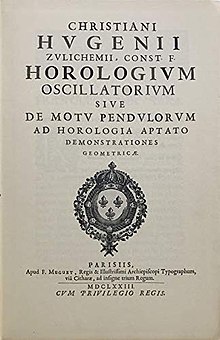 | |
| Author | Christiaan Huygens |
|---|---|
| Language | Latin |
| Genre | Physics, Horology |
| Published | 1673 |
Horologium Oscillatorium: Sive de Motu Pendulorum ad Horologia Aptato Demonstrationes Geometricae (English: The Pendulum Clock: or Geometrical Demonstrations Concerning the Motion of Pendula as Applied to Clocks) is a book published by Dutch mathematician and physicist Christiaan Huygens in 1673 and his major work on pendula and horology.[1][2] It is regarded as one of the three most important works on mechanics in the 17th century, the other two being Galileo’s Discourses and Mathematical Demonstrations Relating to Two New Sciences (1638) and Newton’s Philosophiæ Naturalis Principia Mathematica (1687).[3]
Much more than a mere description of clocks, Huygens's Horologium Oscillatorium is the first modern treatise in which a physical problem (the accelerated motion of a falling body) is idealized by a set of parameters then analyzed mathematically and constitutes one of the seminal works of applied mathematics.[4][5][6] The book is also known for its strangely worded dedication to Louis XIV.[7] The appearance of the book in 1673 was a political issue, since at that time the Dutch Republic was at war with France; Huygens was anxious to show his allegiance to his patron, which can be seen in the obsequious dedication to Louis XIV.[8]
- ^ Huygens, Christiaan; Blackwell, Richard J., trans. (1986). Horologium Oscillatorium (The Pendulum Clock, or Geometrical demonstrations concerning the motion of pendula as applied to clocks). Ames, Iowa: Iowa State University Press. ISBN 0813809339.
{{cite book}}: CS1 maint: multiple names: authors list (link) - ^ Herivel, John. "Christiaan Huygens". Encyclopædia Britannica. Retrieved 14 November 2013.
- ^ Bell, A. E. (30 Aug 1941). "The Horologium Oscillatorium of Christian Huygens". Nature. 148 (3748): 245–248. doi:10.1038/148245a0. S2CID 4112797. Retrieved 14 November 2013.
- ^ Yoder, Joella G. (1988). Unrolling Time: Christiaan Huygens and the Mathematization of Nature. Cambridge: Cambridge University Press. ISBN 978-0-521-34140-0.
- ^ Bruce, I. (2007). Christian Huygens: Horologium Oscillatorium. Translated and annotated by Ian Bruce.
- ^ Yoder, Joella G. (2005-01-01). "Christiaan Huygens, book on the pendulum clock (1673)". Landmark Writings in Western Mathematics 1640-1940: 33–45. doi:10.1016/B978-044450871-3/50084-X. ISBN 9780444508713.
- ^ Levy, David H.; Wallach-Levy, Wendee (2001), Cosmic Discoveries: The Wonders of Astronomy, Prometheus Books, ISBN 9781615925667.
- ^ Yoder, Joella G. (2005), "Christiaan Huygens book on the pendulum clock 1673", Landmark Writings in Western Mathematics 1640-1940, Elsevier, ISBN 9780080457444.